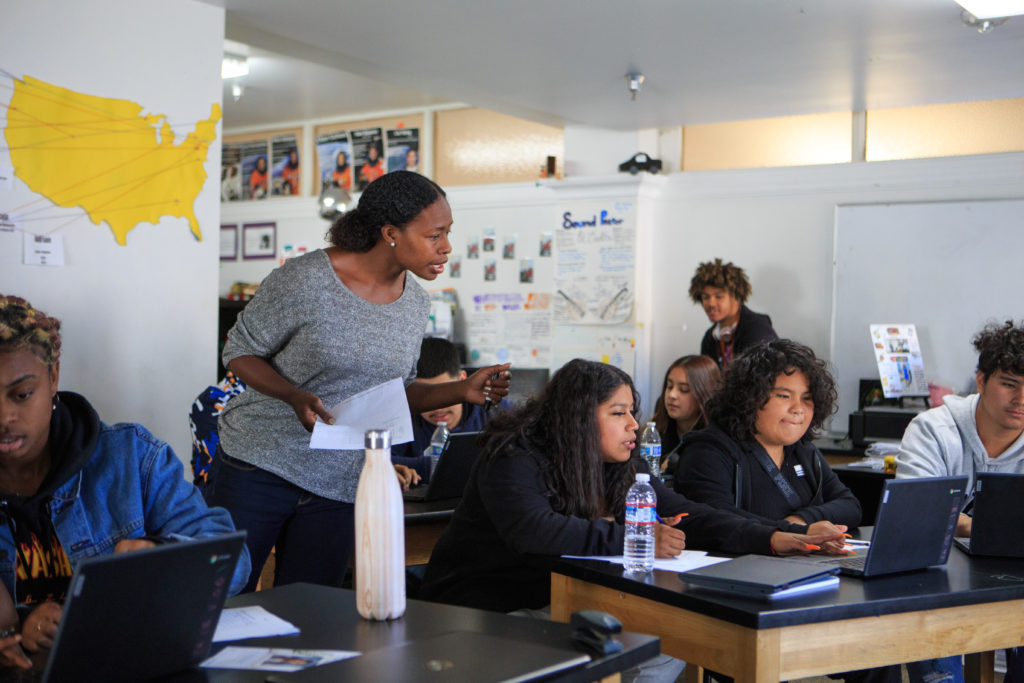Briana Clarke, a physics teacher at Envision Academy in downtown Oakland, doesn’t just want her students to go to college. She wants them to find the right college for them, making the abstract idea of “going to college” a more concrete reality.
“I really want to value college as a tool for my student, as opposed to my student just getting in somewhere that gives them access,” Clarke said. “Somewhere that is specific for them. So I think the difference is, there is an opportunity for students to see themselves at a specific college versus just college in general.”
The college-going culture at Envision Academy extends throughout the school, Clarke said. At the beginning of every school year, freshmen take a trip to UC Berkeley. This is another way to make the abstract concrete, since a majority of students will be the first in their family to go to college.
For Clarke, the idea is that students should be thinking beyond college. What kind of career would they like to pursue? “I want them to have the fluency of how the world works,” she said.

Clarke loves physics and she wants her students to fall in love, too, and become “citizen scientists,” that is “students who are aware of how their surroundings work.” She also wants her students exposed to STEM careers, and see those as possible future careers for themselves. “My desire is for them to go beyond college,” she said.
As a woman of color teaching students of color, she said she understands their background and often where they’re coming from. She integrated coding into her lessons, and students made traffic lights. They designed solar panel cars. “These are great opportunities I have appreciated having at a project-based school, because students get to see themselves as engineers and build skills outside those traditional academic skills,” she said.
The graduation requirements at Envision Academy are aligned to A-G standards, and each of the 50 students who graduated in 2019 also fulfilled their A-G requirements, meaning they are eligible to apply to a UC or CSU school. Clarke, though, said that the alignment can be secondary to a lot of teachers. “We certainly want them to be their best self and go as far as they want,” she said. “But I don’t think about A-G alignment, I think about how I can get my students to fulfill their potential and find a career that fits their aspirations and their personality.”
That, of course, depends on the student. Some students arrive in Clarke’s class with an inherent drive, she said, “a fire inside of them that can’t be doused.” These students, she said, “are college-bound before you even have a class with them.” Others need affirmation, and the “dream spoken into them,” she said. “They want something but they don’t yet know what that is.” Taking time in advisory with students to provide social-emotional supports, helps them establish long-term goals.
Some students react better to positive peer pressure. “I had one student last year who swore to the end of life he would not go to college,” Clarke said. “Once he was put in a setting where the rest of his peers wanted that, he started to want that for himself. I appreciate the students here foster that type of community where one can encourage the other.”
With the coronavirus interrupting the school year, Clarke has had to transition her class to online, and all the challenges that come with that. It’s far more difficult to have students grapple with complex concepts when you can only reach them through a screen, and the internet connection comes and goes. Clarke said she has been grateful to be able to connect with students on social media, and “see their joy and humanity through all of this.”
Through it all, she said a majority of her students are still on pace and keeping up with the coursework. But many students have other challenges besides school, the life stress that so many families face now in the middle of this pandemic. Teachers are showing their humanity every day in the way they connect with students, she said. “Coronavirus has proven to be a different need,” she said, “and teachers have a skill and an empathy to fill that where they can.”
